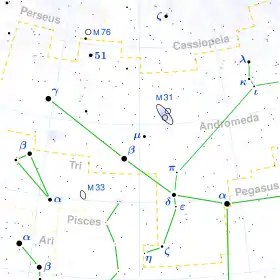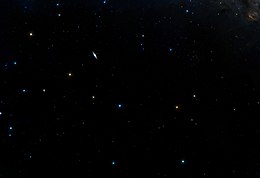Kappa Andromedae
Kappa Andromedae (κ And, κ Andromedae) is the Bayer designation for a bright star in the constellation of Andromeda. Its apparent visual magnitude is 4.1. Based on the star's ranking on the Bortle Dark-Sky Scale, it is luminous enough to be visible from the suburbs and from urban outskirts, but not from brightly lit inner city regions. Parallax measurements made during the Hipparcos mission place it at a distance of approximately 168 light-years (52 parsecs) from Earth.
 | |
| Observation data Epoch J2000 Equinox J2000 | |
|---|---|
| Constellation | Andromeda |
| Right ascension | 23h 40m 24.50763s[1] |
| Declination | +44° 20′ 02.1566″[1] |
| Apparent magnitude (V) | 4.139[2] |
| Characteristics | |
| Spectral type | B9 IVn[3] |
| U−B color index | -0.221[2] |
| B−V color index | -0.067[2] |
| Astrometry | |
| Radial velocity (Rv) | -15.0[4] km/s |
| Proper motion (μ) | RA: +80.73[1] mas/yr Dec.: -18.70[1] mas/yr |
| Parallax (π) | 19.37 ± 0.19[1] mas |
| Distance | 168 ± 2 ly (51.6 ± 0.5 pc) |
| Absolute magnitude (MV) | +0.59[5] |
| Details | |
| Mass | 2.8+0.1 −0.2[6] M☉ |
| Radius | 2.29 ± 0.06[6] R☉ |
| Luminosity | 78.5[6] L☉ |
| Surface gravity (log g) | 4.10 ± 0.03[7] cgs |
| Temperature | 11,361 ± 66[7] K |
| Rotational velocity (v sin i) | 176[8] km/s |
| Age | 47+27 −40 [9] Myr |
| Other designations | |
| Database references | |
| SIMBAD | data |
Kappa Andromedae has a stellar classification of B9 IVn, indicating that it is a subgiant star in the process of evolving away from the main sequence. It has 2.3 times the radius of the Sun and is spinning rapidly, with a projected rotational velocity of 176 km/s. The outer envelope of the star is radiating energy into space with an effective temperature of 11,361 K, producing a blue-white hue.
Chinese naming
In Chinese, 螣蛇 (Téng Shé), meaning Flying Serpent, refers to an asterism consisting of κ Andromedae, α Lacertae, 4 Lacertae, π2 Cygni, π1 Cygni, HD 206267, ε Cephei, β Lacertae, σ Cassiopeiae, ρ Cassiopeiae, τ Cassiopeiae, AR Cassiopeiae, 9 Lacertae, 3 Andromedae, 7 Andromedae, 8 Andromedae, λ Andromedae, ι Andromedae, and ψ Andromedae. Consequently, the Chinese name for κ Andromedae itself is 螣蛇二十一 (Téng Shé èrshíyī, English: the Twenty First Star of Flying Serpent).[10]
Planetary System

In November 2012, members of the Strategic Explorations of Exoplanets and Disks with Subaru (SEEDS) survey reported the discovery of a faint, directly-imaged companion Kappa Andromedae b.[11] Follow-up photometry and spectroscopy of kappa And b with the Subaru Telescope, Keck Observatory, and Large Binocular Telescope constrained its mass to be about 13 Jupiter masses, temperature to be between 1700 K and 2150 K, and orbit to be highly eccentric with a semimajor axis likely greater than about 75 AU. The companion's spectrum shows evidence for water and carbon monoxide molecules and suggests the object has a low surface gravity[12][13][14]
| Companion (in order from star) |
Mass | Semimajor axis (AU) |
Orbital period (years) |
Eccentricity | Inclination | Radius |
|---|---|---|---|---|---|---|
| b | 13+12 −2 MJ |
57–133AU | 242–900y | 0.69–0.85 | 114.9–140° | — |
Age
The age of Kappa Andromedae has been the subject of considerable debate. The discovery paper for Kappa Andromedae b[11] argued that the primary's kinematics are consistent with membership in the Columba Association, which would imply a system age of 20-50 million years, while a subsequent work derived an older age of 220±100 million years based on the star's position on the Hertzsprung-Russell diagram position [6] assuming that the star is not a fast rotator viewed pole-on. Direct measurements of the star later showed that Kappa Andromedae A is in fact a rapid rotator viewed pole-on[9] and yield a best-estimated age of 47+27
−40 million years.
References
- van Leeuwen, F. (November 2007), "Validation of the new Hipparcos reduction", Astronomy and Astrophysics, 474 (2): 653–664, arXiv:0708.1752, Bibcode:2007A&A...474..653V, doi:10.1051/0004-6361:20078357, S2CID 18759600
- Harmanec, P.; et al. (1980), "Photoelectric photometry at the Hvar Observatory. IV - A study of UBV variations of a group of bright northern Be stars", Bulletin of the Astronomical Institutes of Czechoslovakia, Bulletin, 31 (3): 144–159, Bibcode:1980BAICz..31..144H
- Cowley, A.; et al. (April 1969), "A study of the bright A stars. I. A catalogue of spectral classifications", Astronomical Journal, 74: 375–406, Bibcode:1969AJ.....74..375C, doi:10.1086/110819
- Palmer, D. R.; et al. (1968), "The radial velocities spectral types and projected rotational velocities of 633 bright northern A stars", Royal Observatory Bulletin, 135: 385, Bibcode:1968RGOB..135..385P
- Anderson, E.; Francis, Ch. (2012), "XHIP: An extended hipparcos compilation", Astronomy Letters, 38 (5): 331, arXiv:1108.4971, Bibcode:2012AstL...38..331A, doi:10.1134/S1063773712050015, S2CID 119257644.
- Sasha Hinkley; Laurent Pueyo; Jacqueline K. Faherty; Ben R. Oppenheimer; Eric E. Mamajek; Adam L. Kraus; Emily L. Rice; Michael J. Ireland; Trevor David; et al. (September 2013). "The Kappa Andromedae System: New Constraints on the Companion Mass, System Age & Further Multiplicity". The Astrophysical Journal. 763 (2): L32. arXiv:1211.3744. Bibcode:2013ApJ...763L..32C. doi:10.1088/2041-8205/763/2/L32.
- Fitzpatrick, E. L.; Massa, D. (March 2005), "Determining the Physical Properties of the B Stars. II. Calibration of Synthetic Photometry", The Astronomical Journal, 129 (3): 1642–1662, arXiv:astro-ph/0412542, Bibcode:2005AJ....129.1642F, doi:10.1086/427855, S2CID 119512018
- Royer, F.; Zorec, J.; Gómez, A. E. (February 2007), "Rotational velocities of A-type stars. III. Velocity distributions", Astronomy and Astrophysics, 463 (2): 671–682, arXiv:astro-ph/0610785, Bibcode:2007A&A...463..671R, doi:10.1051/0004-6361:20065224, S2CID 18475298
- Jones, Jeremy; White, R. J.; Quinn, S.; Ireland, M.; Boyajian, T.; Schaefer, G.; Baines, E. K. (2016). "The Age of the Directly Imaged Planet Host Star κ Andromedae Determined from Interferometric Observations". The Astrophysical Journal Letters. 822 (1): 7. arXiv:1604.02176. Bibcode:2016ApJ...822L...3J. doi:10.3847/2041-8205/822/1/L3. S2CID 38367518.
- (in Chinese) AEEA (Activities of Exhibition and Education in Astronomy) 天文教育資訊網 2006 年 7 月 7 日
- Carson; et al. (November 2012). "Direct Imaging Discovery of a 'Super-Jupiter' Around the late B-Type Star κ And". The Astrophysical Journal. 763 (2): L32. arXiv:1211.3744. Bibcode:2013ApJ...763L..32C. doi:10.1088/2041-8205/763/2/L32. S2CID 119253577.
- Currie, Thayne; et al. (2018), "SCExAO/CHARIS Near-infrared Direct Imaging, Spectroscopy, and Forward-Modeling of κ And b: A Likely Young, Low-gravity Superjovian Companion", The Astrophysical Journal, 156 (6): 291, arXiv:1810.09457, Bibcode:2018AJ....156..291C, doi:10.3847/1538-3881/aae9ea}
- High Contrast Thermal Infrared Spectroscopy with ALES: The 3-4μm Spectrum of κ Andromedae b, 2020, arXiv:2010.02928
- Wilcomb, K; et al. (2020), "Moderate-resolution K-band Spectroscopy of Substellar Companion κ Andromedae b", The Astrophysical Journal, 160 (5): 207, arXiv:1810.09457, Bibcode:2020AJ....160..207W, doi:10.3847/1538-3881/abb9b1}
- Uyama, Taichi; et al. (2020), "Atmospheric Characterization and Further Orbital Modeling of κ Andromeda b", The Astrophysical Journal, 159 (2): 40, arXiv:1810.09457, Bibcode:2020AJ....159...40U, doi:10.3847/1538-3881/ab5afa}